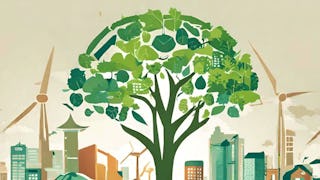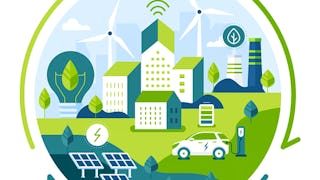Applied Sustainability Engineering, the second course in the "Applied Sustainability for Technical Managers" specialization discusses the techniques used by engineers and scientists to develop and assess the environmental impact of products and processes required to make those products. It begins with a discussion of different renewable energy technologies and their economics – highlighting how continued reductions in cost have made wind and solar power the least expensive way to generate electricity. It then addresses carbon footprints and how they are determined, applying a practical example where you determine your residential and transportation carbon footprints. From there, the course transitions to defining sustainable and circular products and packaging and showcasing several examples. As Technical Managers, you’ll need metrics for determining whether a product is truly sustainable, so the course introduces techniques such as Life Cycle Assessment (LCA), Streamlined LCA (S-LCA), and the Eco-Audit methodologies. The course concludes with an overview of sustainable product design frameworks, including Cradle-to-Cradle, Design for the Circular Economy, and Biomimicry, just to name a few.


Ends tomorrow: Get a Black Friday boost with $160 off 10,000+ programs. Save now.


Applied Sustainability Engineering
This course is part of Applied Sustainability for Technical Managers Specialization

Instructor: Michael J. Readey, Ph.D.
3,127 already enrolled
Included with
(50 reviews)
Recommended experience
What you'll learn
Learn how to complete a carbon footprint analysis, analogous to conducting a Scope 1 and Scope 2 emissions analysis.
Recognize the characteristics that define a sustainable product and the packaging it comes in.
Understand wind, solar and hydropower and how these technologies generate electricity.
Apply LCA, SLCA and Eco-Audit techniques to design a product that meets specific sustainability certification standards.
Skills you'll gain
- Strategic Leadership
- Environmental Engineering
- Emerging Technologies
- Waste Minimization
- Packaging and Labeling
- Climate Change Mitigation
- Sustainable Technologies
- Corporate Sustainability
- Environmental Management Systems
- Sustainable Business
- Product Engineering
- Sustainable Engineering
- Energy and Utilities
- Sustainable Development
- Sustainable Design
- Product Lifecycle Management
Details to know

Add to your LinkedIn profile
16 assignments
See how employees at top companies are mastering in-demand skills

Build your subject-matter expertise
- Learn new concepts from industry experts
- Gain a foundational understanding of a subject or tool
- Develop job-relevant skills with hands-on projects
- Earn a shareable career certificate

There are 5 modules in this course
Welcome to Applied Sustainability Engineering! This first module introduces the course and how it operates. Then, it is all about renewable energy (RE); the different technologies and economics associated with them. We begin with a discussion of hydropower, the largest global source of renewable energy. You'll then learn about the second most abundant and cost effective type: onshore and offshore wind power. After, we'll discuss solar power and you'll learn the terminology behind its operations, physics, and economics. A future with renewable energy requires energy storage, so its important to discuss topics of pumped hydro, battery technologies, and hydrogen, as well as the emerging technologies, such as wave and tidal power, concentrated solar, geothermal and hydrogen fuel cells. The module concludes with an overview of how the world is transitioning to renewable energies in an effort to limit global warming to only 1.5o Celsius, which is the newest target established by the International Panel on Climate Change.
What's included
12 videos3 readings4 assignments1 discussion prompt
This module is all about bringing the effect of carbon production home, so to speak, by determining your own carbon footprints based on personal energy use. Note that the method for calculating one's carbon footprint is similar to calculating Scope 1 and 2 emissions for a business (as part of the Greenhouse Gas Protocol.) After an initial exercise of calculating your personal transportation carbon footprint, we turn our attention to the residential footprint. First, you'll uncover the standard utility bill; what's on it and what it all means. Then, you'll be introduced to, and apply, the EPA (US Environmental Protection Agency)'s eGrid website to determine the Carbon Emissions Factor and mix of power generation technologies for your area. Next, you'll calculate a CO2-equivalent footprint, based on the EPA's emission factors for methane, nitrous oxide, natural gas, and propane. The module concludes with an example of a typical U.S. college student's residential carbon footprint. Then, you'll see how it compares to other countries as well as your own!
What's included
11 videos2 peer reviews
The module is all about sustainable products and packaging. We introduce the concept that sustainable products are true differentiators in the market and highlight several well-known examples. You'll learn what constitutes a sustainable product in terms of the circular economy's butterfly diagram: safe materials, long-life, ease of repair and maintenance, and ease of disassembly for ultimate recycling. We then shift to sustainable packaging, starting with understanding the significant challenge associated with packaging waste. We end the module with an overview of why packaging exists, and some ways of making it more sustainable. This week, you'll also gain awareness of your own packaging consumption as you undergo the 7-day plastics challenge and share your experience with peers. We can't wait to hear what you learn from it!
What's included
5 videos2 readings4 assignments1 peer review1 discussion prompt
This module introduces the topic of life cycle assessments or LCA's. You will learn how to establish system boundaries, define functional units, and know where to look for environmental impact data. More importantly, you'll think critically about conflicting paradigms, such as product designs that could good from a greenhouse gas perspective but are detrimental from an eco-toxicity view. While you may not become a full LCA specialist by the end of this module, you can begin to appreciate the complexity and cost of conducting a full LCA, which is why the Streamlined LCA was designed. It simplifies the process at the expense of accuracy, yet it still provides guidance to product and process designs to reduce environmental impact. You'll be able to practice this hands on, when you conduct an SLCA on gold wedding rings. Finally, you'll learn one last tool for environmental impact analysis: the Eco-Audit. Eco-Audits are particularly important in analyzing the impact of materials and understanding the concept of embodied energy.
What's included
8 videos1 reading4 assignments1 peer review1 discussion prompt
Congratulations on almost completing the course! This final module outlines the specific tools and frameworks used to design, engineer, and manufacture sustainable and circular products along with the packaging that protects them. As a useful and pragmatic framework, we discuss the Cradle-to-Cradle (C2C) design methodology in some detail, showing how the C2C's Certification process is analogous the the LEED standards for the built environment. We'll also touch on other approaches to sustainable product design with the frameworks of Biomimicry and The Natural Step. You've almost come full circle, and we hope you've enjoyed this course!
What's included
7 videos1 reading4 assignments
Earn a career certificate
Add this credential to your LinkedIn profile, resume, or CV. Share it on social media and in your performance review.
Build toward a degree
This course is part of the following degree program(s) offered by University of Colorado Boulder. If you are admitted and enroll, your completed coursework may count toward your degree learning and your progress can transfer with you.¹
Instructor

Explore more from Environmental Science and Sustainability

University of Colorado Boulder

University of Colorado Boulder
Why people choose Coursera for their career




Learner reviews
50 reviews
- 5 stars
70%
- 4 stars
24%
- 3 stars
2%
- 2 stars
0%
- 1 star
4%
Showing 3 of 50
Reviewed on Feb 17, 2025
The material and istructor is good but the display monitor not Clear needed more justification.
Reviewed on Oct 8, 2024
Good content, well organized, very helpful for anybody that needs to start working in Sustainablity and does not know where to start!
Reviewed on Nov 13, 2025
Great course to learn an overview of Sustainability

Open new doors with Coursera Plus
Unlimited access to 10,000+ world-class courses, hands-on projects, and job-ready certificate programs - all included in your subscription
Advance your career with an online degree
Earn a degree from world-class universities - 100% online
Join over 3,400 global companies that choose Coursera for Business
Upskill your employees to excel in the digital economy
Frequently asked questions
To access the course materials, assignments and to earn a Certificate, you will need to purchase the Certificate experience when you enroll in a course. You can try a Free Trial instead, or apply for Financial Aid. The course may offer 'Full Course, No Certificate' instead. This option lets you see all course materials, submit required assessments, and get a final grade. This also means that you will not be able to purchase a Certificate experience.
When you enroll in the course, you get access to all of the courses in the Specialization, and you earn a certificate when you complete the work. Your electronic Certificate will be added to your Accomplishments page - from there, you can print your Certificate or add it to your LinkedIn profile.
Yes. In select learning programs, you can apply for financial aid or a scholarship if you can’t afford the enrollment fee. If fin aid or scholarship is available for your learning program selection, you’ll find a link to apply on the description page.
More questions
Financial aid available,



